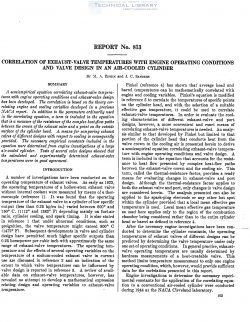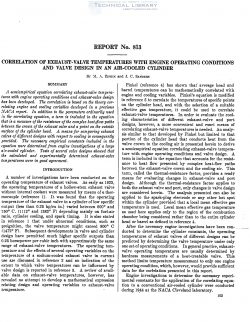naca-report-813

- Version
- 225 Downloads
- 862.40 KB File Size
- 1 File Count
- August 31, 2016 Create Date
- August 31, 2016 Last Updated
National Advisory Committee for Aeronautics, Report - Correlation of Exhaust Valve Temperatures with Engine Operating Conditions and Valve Design in an Air Cooled Cylinder

The semiempirical equation correlating exhaust-calm tern pera—
tures with engine operating conditions and erha-ust-ralre design
has been dereloped. The correlation is hosed on the theory cor-
relating engine and cooling rariables deceloped in a precious
NACA report. I n addition to the parameters ordinarily used
in the correlating equation, a term is included in the equation
that is a measure of the resistance of the complex heat-flow paths
between the crown of the exhaust sales and a point on the outside
surface of the cylinder head. A means for comparing exhaust
ralres of difierent designs with respect to cooling is consequently
prorided. The necessary empirical constants included in the
equation were determined from engine inrestigations of a large
air-cooled cylinder. Tests of sereral calre designs showed that
the calculated and experimentally determined erhaust-ralre
temperatures were in good agreement.
A number of investigations have been conducted on the
operating temperature of exhaust valves. As early as 1923,
the operating temperatures of a hollow-stem exhaust valve
without internal coolant were measured by means of a ther-
mocouple (reference 1). It was found that the operating
temperature of the exhaust valve in a cylinder of low specific
output (less than 0.25 hp/cu in.) varied between 600° and
750° C. (1112° and 1382° F) depending mainly on fuel—air
ratio, cylinder cooling, and spark timing. It is also stated
in reference 1 that under abnormal conditions, such as
preignition, the valve temperature might exceed 800° C
(1472° F). Subsequent developments in valve and cylinder
design have permitted much higher specific outputs than
0.25 horsepower per cubic inch with approfimately the same
range of exhaust-valve temperatures. The operating tem—
perature and the effects of several operating variables on the
temperature of a sodium-cooled exhaust valve in current
use are discussed in reference 2 and an indication of the
extent to which valve temperatures can be influenced by
valve design is reported in reference 3. A. review of avail-
able data on exhaustpvalve temperatures, however, has
revealed no attempt to develop a mathematical expression
relating design and operating variables to exhaust-valve
temperature.
| File | Action |
|---|---|
| naca-report-813 Correlation of Exhaust Valve Temperatures with Engine Operating Conditions and Valve Design in an Air Cooled Cylinder.pdf | Download |
Comment On This Post